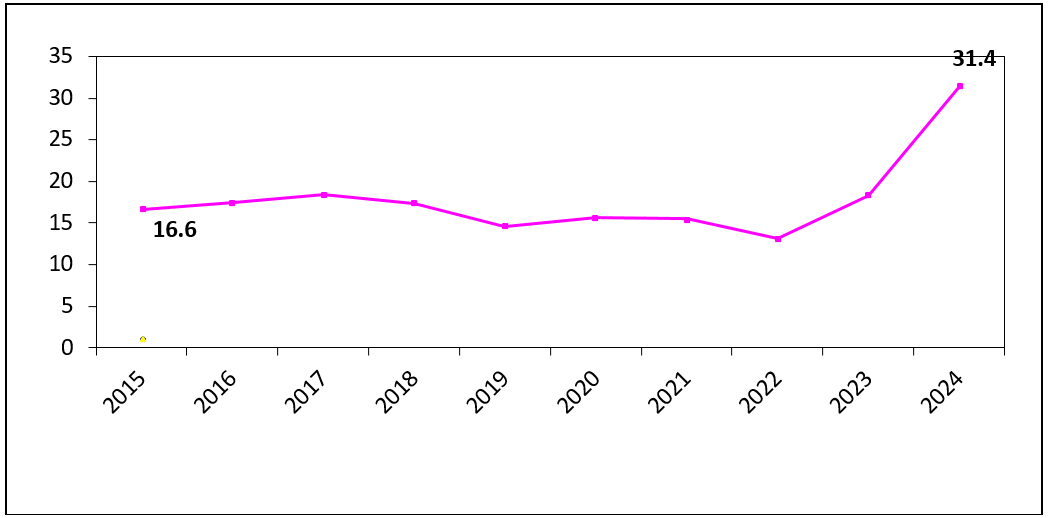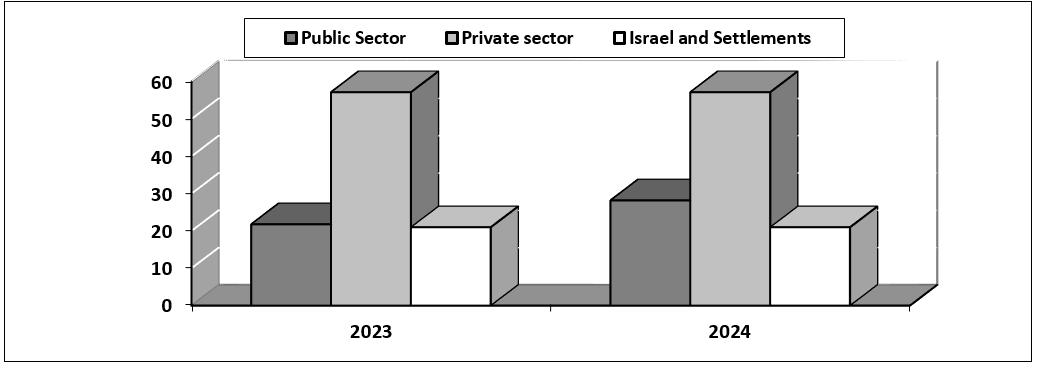Palestinian Central Bureau of Statistics (PCBS)
On the occasion of the International Workers' Day, H.E. Dr. Ola Awad, President of the Palestinian Central Bureau of Statistics (PCBS),
presents the current status of the Palestinian labour force in 2024
Unprecedented Unemployment Rates and Sharp Contraction
in Employment in 2024
In light of the ongoing Israeli aggression against Gaza Strip since October 7th, 2023, H.E. Dr. Ola Awad, President of PCBS, presents the properties of the Palestinians labour force on the occasion of the International Workers' Day,
Since the 7th of October 2023, Palestine has witnessed a new chapter of suffering that has been going on for a century. The relative stability experienced by the Palestinian people since the advent of the Palestinian National Authority has deteriorated, and a crisis has become more difficult than before, disrupting all aspects of Palestinian life. One of the most difficult manifestations of the recent suffering has been the war of extermination against the Gaza Strip. This ongoing crisis was directly affected by the Palestinian workers who were working in Israel and the settlements on the eve of the seventh of October 2023, who constituted one fifth of the Palestinian workers, and thus affected the local private sector workers due to the loss of imports and incomes that were received from the labor sector in Israel and the settlements. Since the seventh of October 2023, the Palestinian labor market has entered a severe crisis that continues until now.
Due to the ongoing Israeli occupation aggression against Gaza Strip since October 7th, 2023, which led to the suspension of the economy in Gaza Strip indefinitely, addressing labour force properties in Gaza Strip is unrealistic and useless. As of October 7th, 2023, results of Labour Force Survey (LFS) in Gaza Strip during the aggression in the 4th quarter of 2024 showed that unemployment rates reached unprecedented levels of about 68% compared to about 45% in the 3rd quarter of 2023. Results also showed that labour force participation rate decreased to reach about 30% compared with 40% in the 3rd quarter of 2023 before October 7th 2023.
Moreover, results showed that the youth (15-29 years) are greatly affected; about three-quarters of young people are outside education, training, and the labour market, with around 74%.
Furthermore, the majority of the labor force concepts became inapplicable to be used for measuring the labor force characteristics in Gaza Strip, since the priority of Gaza’s people is looking for shelter, food, and safety.
This impact has not only been reflected on Gaza Strip but also on the West Bank even if it was less affected. The impact of the Israeli aggression on Gaza Strip and its repercussions in the West Bank of increasing restrictions and tightening the stranglehold on the governorates of the West Bank, disconnecting communication and roads between the governorates, as well as forbidding workers to access their work inside the occupied territories of Palestine. Hence, all these reasons and more have paralyzed the economic movement in the West Bank.
As for the West Bank, the number of unemployed persons increased to reach 313 thousand in 2024 compared to about 183 thousand in 2023. Also, unemployment rates among participants in the labour force in the West Bank increased to about 31% in 2024 compared to 18% in 2023. Unemployment rate increased among both males and females to reach 31.7% and 30.1%, respectively, in 2024.
Unemployment Rate among Participants in the Labour Force
(15 Years above) in the West Bank, 2015 – 2024

A decrease of about 132 thousand in the number of employed persons from the West Bank Between 2023 and 2024
The number of employed persons (excluding employees abroad) decreased from about 815 thousand in 2023 to about 681 thousand employed persons in 2024 with a percentage of 20%.
Moreover, the number of employed persons from the West Bank in Israel decreased sharply between 2023 and 2024 by about 85 thousand employed persons, because of the strict closures imposed by the Israeli occupation after the aggression against Gaza Strip, where the number of employed persons in Israel was about 21 thousand in 2024 compared to about 107 thousand in 2023.
The number of employed persons in the Israeli settlements decreased from 16 thousand in 2023 to 15 thousand in 2024.
A decrease in the number of employed persons in the local market in the West Bank between 2023 and 2024
The number of employed persons in the local market in the West Bank decreased from 685 thousand in 2023 to 650 thousand in 2024, about 5%.
Results showed that the decrease in the number of employed persons in the local market in the West Bank is due to the decrease in the number of employed persons in constructions activity, followed by other services[1] activity, then restaurants and hotels activity, and finally mining manufacturing activity.
The private sector is the main employer
The number of employed persons from the West Bank reached 681 thousand; 650 thousand in the West Bank, and 31 thousand in Israel and Israeli settlements. There are about 447 thousand wage employees (416 thousand of them in the West Bank, 16 thousand in Israel and 15 thousand in the Israeli settlements).
About 65% of wage employees in the West Bank are working in the private sector, compared with about 28% employed persons in the public sector, and 7% of wage employees are working in Israel and Israeli settlements in 2024.
Percentage Distribution of Wage Employees
from the West Bank by Sector, 2024

More than one-fourth of wage employees in the private sector work as professionals or technicians
About 28% of wage employees in the private sector work as professionals or technicians in the West Bank (17% among males and 69% among females).
More than half of employed persons are in informal employment in the West Bank
Informal employment reached about 61% in the West Bank in 2024 compared with 62% in 2023 (knowingly, workers in the informal sector and wage employeeswho do not receive any of their rights in the labour market whether retirement/end-of-service gratuity, paid annual leave or paid sick leave); 67% among males compared to 38% among females. Also, the percentage of employed persons in the informal sector reached 46% in the West Bank (52% among males and 25% among females) compared with 47% in 2023.
Low average of real wages in the private sector
The real average daily wage (base year= 2018) in the private sector was about 122 NIS in 2024 in the West Bank compared with 121 NIS in 2023 (Wage employees in Israel and Israeli settlements are excluded).
The transports, storage and communications activity in the private sector recorded the highest average of real daily wage of 166 NIS, followed by constructions activity with about 141 NIS. While the agriculture activity recorded the lowest average real daily wage at 79 NIS in the West Bank.
In the same context, the average of actual weekly work hours for wage employees in Palestine was 42 hours; 41.6 hours for wage employees in the public sector, and 42.1 weekly work hours for wage employees in the private sector.
16% of wage employees receive less than the minimum monthly wage (1,880 NIS) in the West Bank.
The percentage of wage employees in the private sector who receive a monthly wage less than the minimum wage in the West Bank was 16% in 2024 (about 40 thousand employees) compared with 15% (about 44 thousand employees) in 2023.
It is worth mentioning that the Council of Ministers issued a decree stating that the minimum wage is to be (1,880 NIS) as of the beginning of 2022.
The average monthly wage, for those who receive less than the minimum wage, was 1,424 NIS in the West Bank in 2024, compared with 1,381 NIS in 2023.
Less than half of the private sector’s wage employees receive benefits
About 43% of the wage employees in the private sector receive benefits (retirement/end-of-service gratuity, paid annual leave and paid sick leave). Thus, the number of wage employees in the private sector who had written a permanent contract was about 67 thousand employed persons; about 128 thousand employed persons in the private sector have a temporary contract, and about 101 thousand employed persons with no contract. However, about 51% of wage female employees who work in the private sector got a paid maternity leave in 2024.
[1] Includes: Public administration and defense; compulsory social security, education, human health activities, social work activities, creative, arts and entertainment activities, libraries, archives, museums and other cultural activities, sports activities and amusement and recreation activities, activities of membership organizations, other personal service activities, activities of households as employers of domestic personnel and activities of extraterritorial organizations and bodies.
 عربي
عربي